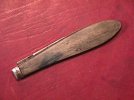- Joined
- Jan 7, 2003
- Messages
- 1,131
Zerogee, That was a good lection in knifeknowledge. Thank you very much. I personally dont think to high about halfstops but your thoughts about wearresistance makes them more interesting and also the fact its easyer to file if one dont taking fluch positions into koncideration.
Bosse
Bosse













